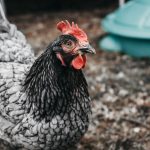Raising chickens can be a rewarding and enjoyable experience, but it’s important to understand the potential dangers that come with it. Predators such as foxes, raccoons, coyotes, and birds of prey are common threats to chickens, and can cause significant harm to your flock if not properly managed. These predators are often attracted to the scent of chickens and their eggs, making it crucial to take proactive measures to protect your coop and run.
Additionally, diseases and parasites can also pose a threat to your chickens’ health, so it’s important to be vigilant and proactive in preventing and managing these risks. Furthermore, it’s essential to consider the potential dangers that can arise from human interaction with your chickens. Theft and vandalism are real concerns for chicken owners, especially in more rural areas where coops may be more isolated.
Educating yourself on the potential dangers and taking proactive steps to mitigate these risks is crucial for the safety and well-being of your flock.
Table of Contents
- 1 Secure coop design
- 2 Proper fencing and barriers
- 3 Predator-proofing the surroundings
- 4 Nighttime routines and checks
- 5 Using lighting and alarms
- 6 Training and supervision
- 7 FAQs
- 7.1 What are the potential threats to chickens at night?
- 7.2 How can I keep my chickens safe from predators at night?
- 7.3 Should I lock my chickens in their coop at night?
- 7.4 Are there any specific measures to protect chickens from aerial predators?
- 7.5 What are some signs that my chickens are being targeted by predators at night?
Key Takeaways
- Understanding the dangers:
- Recognize potential threats to your coop, such as predators and weather conditions.
- Understand the vulnerabilities of your coop and the surrounding area.
- Secure coop design:
- Build a sturdy and secure coop structure to protect your poultry from predators.
- Use quality materials and construction techniques to ensure the coop is safe and durable.
- Proper fencing and barriers:
- Install fencing and barriers around the coop to prevent access by predators.
- Regularly inspect and maintain fencing to ensure it remains effective.
- Predator-proofing the surroundings:
- Remove potential hiding spots for predators near the coop.
- Use predator-proofing measures such as hardware cloth and secure latches on doors and windows.
- Nighttime routines and checks:
- Establish a routine for securing the coop at night to protect against nocturnal predators.
- Conduct regular nighttime checks to ensure the coop is secure and the poultry are safe.
- Using lighting and alarms:
- Install motion-activated lights and alarms to deter predators from approaching the coop.
- Use timers for coop lighting to simulate natural day-night cycles and discourage predators.
- Training and supervision:
- Educate yourself and others responsible for the coop on predator identification and prevention.
- Supervise poultry and regularly assess the security measures in place to protect them.
Secure coop design
Sturdy Materials and Secure Hardware
The coop should be constructed with sturdy materials and secure hardware to prevent predators from gaining access. Consider using hardware cloth instead of chicken wire for added protection, as it is more durable and resistant to predators attempting to chew or claw their way through.
Secure Openings and Layout
Additionally, ensure that all openings, such as windows and doors, are securely fastened and can be locked at night to prevent unauthorized entry. It’s also important to consider the layout of the coop and run to minimize potential hiding spots for predators. Keep the area around the coop clear of tall grass and brush, as these can provide cover for predators to approach undetected.
Additional Security Measures
Additionally, consider adding a predator apron around the perimeter of the coop and run to prevent digging animals from gaining access from below. By designing a secure coop, you can significantly reduce the risk of predators gaining access to your flock.
Proper fencing and barriers

In addition to a secure coop, proper fencing and barriers are essential for protecting your chickens from predators. A sturdy fence around the perimeter of the run can help prevent larger predators such as coyotes and dogs from gaining access to your flock. Consider using hardware cloth or welded wire fencing with small openings to prevent predators from squeezing through or reaching in to grab a chicken.
It’s also important to consider the height of the fence, as some predators such as raccoons and foxes are skilled climbers. A fence that is at least six feet tall with a secure top or overhang can help deter these climbers from gaining access to your chickens. Additionally, consider burying the bottom of the fence or adding a predator apron to prevent digging animals from gaining access from below.
Predator-proofing the surroundings
In addition to securing the coop and run, it’s important to predator-proof the surrounding area to further protect your flock. Remove any potential hiding spots for predators such as brush piles, tall grass, or debris near the coop and run. Keep the area well-maintained and free of clutter to minimize potential hiding spots for predators.
Consider adding motion-activated lights or sound devices around the perimeter of the coop and run to deter nocturnal predators such as raccoons and foxes. These devices can startle predators and make them think twice about approaching your flock. Additionally, consider using scent deterrents such as predator urine or ammonia-soaked rags around the perimeter of the coop and run to further deter predators from approaching.
Nighttime routines and checks
Nighttime is when many predators are most active, making it crucial to establish nighttime routines and checks to ensure the safety of your flock. Close all coop doors and secure any windows or vents before dusk to prevent predators from gaining access during the night. Conduct regular checks of the coop and run before locking up for the night to ensure that all areas are secure and free of potential threats.
Consider using automatic door openers for the coop to ensure that chickens are safely locked inside at night and let out in the morning without human intervention. These devices can help minimize the risk of forgetting to close up the coop at night, which can leave your flock vulnerable to predators.
Using lighting and alarms

Lighting as a Deterrent
In addition to physical barriers, lighting can be an effective tool for deterring predators from approaching your coop and run. Motion-activated lights around the perimeter of the coop and run can startle nocturnal predators and make them think twice about approaching.
Monitoring Activity with Security Cameras
Consider installing a security camera system with motion detection to monitor activity around the coop and run. This can provide an added layer of protection and help you stay informed about potential threats.
Alarms for Predator Deterrence
Alarms such as sirens or loud noises can also be effective in deterring predators from approaching your flock. Consider installing a predator alarm system that is triggered by motion or sound near the coop and run to alert you of potential threats. These alarms can help scare off predators and alert you to take action to protect your flock.
Training and supervision
Proper training and supervision of both humans and animals can also play a crucial role in protecting your flock from potential dangers. Educate family members and anyone else who may interact with your chickens on proper coop security measures and predator awareness. Establish clear guidelines for handling chickens and accessing the coop and run to minimize potential risks.
Additionally, consider training a livestock guardian animal such as a dog or a guard goose to help protect your flock from predators. These animals can help deter potential threats and alert you to any potential dangers. However, it’s important to supervise these animals closely and ensure that they are properly trained to interact safely with your chickens.
In conclusion, understanding the potential dangers that come with raising chickens is crucial for ensuring the safety and well-being of your flock. By taking proactive measures such as securing the coop design, implementing proper fencing and barriers, predator-proofing the surroundings, establishing nighttime routines and checks, using lighting and alarms, and providing proper training and supervision, you can significantly reduce the risk of predators harming your chickens. With careful planning and attention to detail, you can create a safe and secure environment for your flock to thrive.
If you’re looking for ideas on how to keep your chickens safe at night, you may also be interested in this article on chicken coop interior ideas. Creating a secure and comfortable environment for your chickens is essential for their well-being, and this article offers helpful tips and inspiration for designing a safe and cozy coop.
FAQs
What are the potential threats to chickens at night?
Chickens are vulnerable to predators such as foxes, raccoons, owls, and other nocturnal animals that may attack them while they are roosting at night.
How can I keep my chickens safe from predators at night?
To keep chickens safe at night, it is important to secure their coop with sturdy fencing, locks, and latches to prevent predators from gaining access. Additionally, installing motion-activated lights or alarms can help deter nocturnal predators.
Should I lock my chickens in their coop at night?
Yes, it is recommended to lock chickens in their coop at night to keep them safe from predators. This can be done by closing and securing the coop door to prevent any unwanted intruders from entering.
Are there any specific measures to protect chickens from aerial predators?
To protect chickens from aerial predators such as owls and hawks, it is advisable to cover the top of the chicken coop with wire mesh or netting to prevent these predators from swooping down and attacking the chickens.
What are some signs that my chickens are being targeted by predators at night?
Signs that your chickens may be targeted by predators at night include missing or injured chickens, feathers scattered around the coop, and evidence of forced entry into the coop. It is important to regularly inspect the coop for any signs of predator activity.
Meet Walter, the feathered-friend fanatic of Florida! Nestled in the sunshine state, Walter struts through life with his feathered companions, clucking his way to happiness. With a coop that’s fancier than a five-star hotel, he’s the Don Juan of the chicken world. When he’s not teaching his hens to do the cha-cha, you’ll find him in a heated debate with his prized rooster, Sir Clucks-a-Lot. Walter’s poultry passion is no yolk; he’s the sunny-side-up guy you never knew you needed in your flock of friends!







